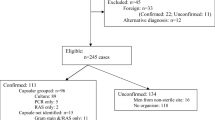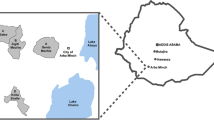Abstract
We report about three unliked cases of meningococcal meningitis caused by the ST-11/ET-37 strain of Neisseria meningitidis serogroup W. Two of the three cases, detected in Sicily on June and July 2014, were migrants from Mali and Eritrea. The third case was a fatal meningitis occurred on November 2014 in a 37 years old man, working in an immigrant center in Calabria. This report suggests that tetravalent conjugate vaccines (ACYW) should be actively offered to the staff of migrants’ reception centers.
*Author contributed equally with all other contributors.
Access provided by Autonomous University of Puebla. Download chapter PDF
Similar content being viewed by others
Keywords
Invasive meningococcal disease (IMD) due to Neisseria meningitidis serogroup W is uncommon in European countries. Although this serogroup accounts only for a small proportion of IMD cases in Italy, an increase from 2.1 % in 2010 to 4.7 % in 2014 has been observed (http://www.iss.it/mabi/).
Hereby, we report on three unlinked cases of IMD due to serogroup W, occurred between June and November 2014, among individuals attending or working in migrants reception centers located in the South of Italy.
The first case was an 18 years old man from Mali, who arrived to the southern coast of Sicily on June 2014, after crossing the Mediterranean sea. The man developed high fever (>38 °C) and other symptoms suggestive of meningitis, 7 days after his arrival (Stephens 1999). The second case was a 20 years old woman from Eritrea, who arrived in Lampedusa on July 2014. She developed symptoms suggestive of meningitis while resident in a camp and was admitted to the infectious disease clinic in Palermo. Both patients survived.
Chemoprophylaxis with rifampicin or ciprofloxacin was administered to all the individuals who had a direct exposure to the index cases during the period of time in which the cases were assumed to be infectious (i.e., from 7 days prior to the onset of symptoms to 24 h after the initiation of antibiotic prophylaxis) in order to reduce the risk of transmission.
On November 2014, in Calabria, a Region of the South of Italy, in a location where no cases of IMD had yet been reported among migrants, a fatal case of meningitis due to serogroup W occurred in a 37 years old man of Moroccan nationality, working as cultural mediator in an immigrants’ reception center.
To our knowledge, this man did not have any exposure outside the workplace which might have placed him at risk of acquiring meningococcal infection due to an exotic strain, and he had not been outside Italy during the last year. Antibiotic prophylaxis was given to all his close contacts.
A lumbar puncture showed purulent cerebrospinal fluid (CSF) in all the three cases. DNA extraction from CSFs was performed by using commercial kits (Qiagen, Hilden, Germany), leading to the molecular identification of N. meningitidis. The Reference Laboratory of the Istituto Superiore di Sanità (ISS) in Rome, Italy, confirmed the diagnosis of serogroup W infection and performed the Multilocus sequence typing (MLST), and PorA and FetA typing, in accordance with the procedures published in http://neisseria.org/. The N. meningitidis W:P1.5,2:F1-1:ST-11 clonal complex (cc) strain was identified in all the samples.
The identification of three cases infected with the W/ST-11 cc strain associated with migrant reception camps is particularly interesting since, in the last years, most of endogenous IMD cases of W in Italy (73 %) were typed as ST-22 cc and only the remaining, as ST-11.
The three cases of IMD described above, caused by the same serogroup W strain, are paradigmatic of the changes occurring in meningococcal serogroup dynamics in a globalized world. The first two cases were represented by two migrants, who developed IMD several days after being arrived in a migrant reception facility in Sicily; both of them were from Sub-Saharan Africa, and one of them was from Mali, a country of the meningitis belt which is considered endemic for W/ST-11 cc strain (Guindo et al. 2011). Although, we cannot completely rule out that the infection was acquired during the travel, or even in the camp, it is likely that it was imported from the country of origin. To this regard, it has been suggested that the W/ST-11 cc Haji strain may cause infection up to more than 1 month post-return (Wilder-Smith et al. 2003). Concerning the third case, although IMD cases were not identified in the camp, the detection of the same clonal complex and the exclusion of risky exposures outside the camp strongly support an occupational risk due to contacts with carriers coming from endemic countries.
Meningococcal disease due to W was reported in Africa since the early 1980s (Kwara et al. 1998). In 1996, carriage of W strains was reported during a vaccine trial on Gambian children (MacLennan et al. 2000). Since the Hajj pilgrimage of the year 2000, serogroup W/ST-11 has emerged as a strain responsible of epidemic of IMD in Africa (Kelly and Pollard 2003; Parent du Chatelet et al. 2012). The first reported outbreak of W occurred in 2002 in Burkina Faso, with a large epidemic of about 8,000 cases (Nathan et al. 2007). In 2013, many countries, such as Benin, Burkina Faso, Ivory Coast, Gambia and Ghana, reported W/ST-11 cc as the predominant strain and the main cause of outbreaks (World Health Organization 2013).
The increasing number of immigrants from African countries raises a series of issues regarding the introduction of serogroups which are rarely found in persons living in Western European countries; to this purpose, outbreaks due to the W:P1.5,2:F1-1:ST-11(cc11) strain have been documented in France and in the UK (Parent du Chatelet et al. 2012; Puleston et al. 2012).
The two imported cases reported in Sicily and the indigenous case detected in a migrant reception center represent an early warning signal for Italy. Moreover, because of unauthorized migration flows, many migrants are in irregular situations, lacking access to health services. Thus, there is a need to ensure access to early diagnosis and treatment for disadvantaged populations (Severoni and Dembech 2014).
Before drawing conclusions, some limits of the study need to be mentioned. Firstly, there is no definitive evidence that both migrants acquired meningococcal infection in their country of origin and not during their travel or even in the reception centers. Secondly, although the IMD affecting the cultural mediator was likely to be due to occupational exposure, any other contact outside the receptions camp could not be completely ruled out. Finally, carriage studies, which may be extremely useful in improving the knowledge of meningococcal transmission dynamics, were not conducted; unfortunately, they had not been planned, and the prompt administration of prophylaxis regimens was considered the priority in terms of public health intervention.
In conclusion, increased migration flows from endemic areas and the importation of exotic strains of N. meningitidis launches new challenges to Mediterranean Europe. The identification of cases among migrants and indigenous workers attending reception facilities suggests the importance of adopting more stringent public health measures, such as early detection of cases, improvement of surveillance systems, screening of migrants and staff for nasopharyngeal carriage, and active offer of tetravalent conjugate meningococcal vaccine (ACYW) to the staff of reception centers.
References
Guindo I et al (2011) Clones of Neisseria meningitidis strains in Mali. Med Mal Infect 41:7–13
Jolley KA, Maiden MC (2010) BIGSdb: scalable analysis of bacterial genome variation at the population level. BMC Bioinf 11:595
Kelly D, Pollard AJ (2003) W135 in Africa: origins, problems and perspectives. Travel Med Infect Dis 1:19–28
Kwara A et al (1998) Meningitis caused by a serogroup W135 clone of the ET-37 complex of Neisseria meningitidis in West Africa. Trop Med Int Health 3:742–746
MacLennan JM et al (2000) Carriage of serogroup W-135, ET-37 meningococci in The Gambia: implications for immunization policy? Lancet 356:1078
Nathan N et al (2007) (2002) Meningitis serogroup W135 outbreak, Burkinia Faso. Emerg Infect Dis 13:920–923
Parent du Chatelet I et al (2012) W135 invasive meningococcal infections imported from Sub-Saharan Africa to France. Euro Surveill 17:pii: 20181
Puleston R et al (2012) An unusual transmission event of Neisseria meningitidis serogroup W135 type 2a in a healthcare setting, England, 2012. Euro Surveill 17:pii: 20308.
Severoni S, Dembech M (2014) Technical briefing for WHO Member States, Copenhagen, RC 64-2014.
Stephens DS (1999) Uncloaking the meningococcus: dynamics of carriage and disease. Lancet 353:941–942
Wilder-Smith A et al (2003) Hajj-associated outbreak strain of Neisseria meningitidis serogroup W135: estimates of the attack rate in a defined population and the risk of invasive disease developing in carriers. Clin Infect Dis 36:679–683
World Health Organization (2013) Meningococcal disease in countries of the African meningitis belt, 2012 – emerging needs and future perspectives. Wkly Epidemiol Rec 88:129–136
Acknowledgments
We thank Luigina Ambrosio, Dept. of Infectious, Parasitic and Immunomediated Diseases, Istituto Superiore di Sanità, for technical assistance.
This publication made use of the Neisseria Multi Locus Sequence Typing website (http://pubmlst.org/neisseria/) developed by Keith Jolley and sited at the University of Oxford (Jolley and Maiden 2010). The development of this site has been funded by the Wellcome Trust and European Union.
This work was partially funded by Ministry of Health progetto CCM “Sorveglianza delle malattie batteriche invasive da N. meningitidis, H. influenzae e S. pneumoniae”, 2014.
Author information
Authors and Affiliations
Corresponding author
Editor information
Editors and Affiliations
Rights and permissions
Copyright information
© 2015 Springer International Publishing Switzerland
About this chapter
Cite this chapter
Stefanelli, P. et al. (2015). Imported and Indigenous cases of Invasive Meningocococcal Disease W:P1.5,2:F1-1: ST-11 in migrants’ reception centers. Italy, June-November 2014. In: Donelli, G. (eds) Advances in Microbiology, Infectious Diseases and Public Health. Advances in Experimental Medicine and Biology(), vol 897. Springer, Cham. https://doi.org/10.1007/5584_2015_5006
Download citation
DOI: https://doi.org/10.1007/5584_2015_5006
Published:
Publisher Name: Springer, Cham
Print ISBN: 978-3-319-26319-9
Online ISBN: 978-3-319-26320-5
eBook Packages: Biomedical and Life SciencesBiomedical and Life Sciences (R0)




